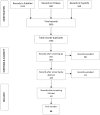How Useful Is Electroencephalography in the Diagnosis of Autism Spectrum Disorders and the Delineation of Subtypes: A Systematic Review
- PMID: 28747892
- PMCID: PMC5506073
- DOI: 10.3389/fpsyt.2017.00121
How Useful Is Electroencephalography in the Diagnosis of Autism Spectrum Disorders and the Delineation of Subtypes: A Systematic Review
Abstract
Autism spectrum disorders (ASD) are thought to be associated with abnormal neural connectivity. Presently, neural connectivity is a theoretical construct that cannot be easily measured. Research in network science and time series analysis suggests that neural network structure, a marker of neural activity, can be measured with electroencephalography (EEG). EEG can be quantified by different methods of analysis to potentially detect brain abnormalities. The aim of this review is to examine evidence for the utility of three methods of EEG signal analysis in the ASD diagnosis and subtype delineation. We conducted a review of literature in which 40 studies were identified and classified according to the principal method of EEG analysis in three categories: functional connectivity analysis, spectral power analysis, and information dynamics. All studies identified significant differences between ASD patients and non-ASD subjects. However, due to high heterogeneity in the results, generalizations could not be inferred and none of the methods alone are currently useful as a new diagnostic tool. The lack of studies prevented the analysis of these methods as tools for ASD subtypes delineation. These results confirm EEG abnormalities in ASD, but as yet not sufficient to help in the diagnosis. Future research with larger samples and more robust study designs could allow for higher sensitivity and consistency in characterizing ASD, paving the way for developing new means of diagnosis.
Keywords: autism; autism spectrum disorders; electroencephalography; functional connectivity; information dynamics; spectral analysis.
Figures
Similar articles
-
Systematic Review on EEG Analysis to Diagnose and Treat Autism by Evaluating Functional Connectivity and Spectral Power.Neuropsychiatr Dis Treat. 2023 Feb 22;19:415-424. doi: 10.2147/NDT.S394363. eCollection 2023. Neuropsychiatr Dis Treat. 2023. PMID: 36861010 Free PMC article. Review.
-
Autism spectrum disorder diagnosis with EEG signals using time series maps of brain functional connectivity and a combined CNN-LSTM model.Comput Methods Programs Biomed. 2024 Jun;250:108196. doi: 10.1016/j.cmpb.2024.108196. Epub 2024 Apr 24. Comput Methods Programs Biomed. 2024. PMID: 38678958
-
A stable pattern of EEG spectral coherence distinguishes children with autism from neuro-typical controls - a large case control study.BMC Med. 2012 Jun 26;10:64. doi: 10.1186/1741-7015-10-64. BMC Med. 2012. PMID: 22730909 Free PMC article.
-
On the application of quantitative EEG for characterizing autistic brain: a systematic review.Front Hum Neurosci. 2013 Aug 5;7:442. doi: 10.3389/fnhum.2013.00442. eCollection 2013. Front Hum Neurosci. 2013. PMID: 23935579 Free PMC article.
-
Children with Autism Spectrum Disorder and Abnormalities of Clinical EEG: A Qualitative Review.J Clin Med. 2024 Jan 3;13(1):279. doi: 10.3390/jcm13010279. J Clin Med. 2024. PMID: 38202286 Free PMC article. Review.
Cited by
-
Neonatal chemokine markers predict subsequent diagnosis of autism spectrum disorder and delayed development.Brain Behav Immun. 2022 Feb;100:121-133. doi: 10.1016/j.bbi.2021.11.009. Epub 2021 Nov 19. Brain Behav Immun. 2022. PMID: 34808292 Free PMC article.
-
An Observational Study With the Janssen Autism Knowledge Engine (JAKE®) in Individuals With Autism Spectrum Disorder.Front Neurosci. 2019 Feb 27;13:111. doi: 10.3389/fnins.2019.00111. eCollection 2019. Front Neurosci. 2019. PMID: 30872988 Free PMC article.
-
Conceptual, Regulatory and Strategic Imperatives in the Early Days of EEG-Based Biomarker Validation for Neurodevelopmental Disabilities.Front Integr Neurosci. 2019 Aug 21;13:45. doi: 10.3389/fnint.2019.00045. eCollection 2019. Front Integr Neurosci. 2019. PMID: 31496945 Free PMC article. Review.
-
A jugular vein compression collar prevents alterations of endogenous electrocortical dynamics following blast exposure during special weapons and tactical (SWAT) breacher training.Exp Brain Res. 2018 Oct;236(10):2691-2701. doi: 10.1007/s00221-018-5328-x. Epub 2018 Jul 10. Exp Brain Res. 2018. PMID: 29987537
-
EEG Analytics for Early Detection of Autism Spectrum Disorder: A data-driven approach.Sci Rep. 2018 May 1;8(1):6828. doi: 10.1038/s41598-018-24318-x. Sci Rep. 2018. PMID: 29717196 Free PMC article.
References
-
- Centers for Disease Control and Prevention. Prevalence of autism spectrum disorders autism and developmental disabilities monitoring network, 14 sites, United States, 2008. MMWR Surveill Summ (2012) 61(3):1–19. - PubMed
-
- American Psychiatric Association. Autism Spectrum Disorder. Diagnostic and Statistical Manual of Mental Disorders. Washington, DC: American Psychiatric Association: (1994).
-
- American Psychiatric Association. Autism Spectrum Disorder. Diagnostic and Statistical Manual of Mental Disorders. Washington, DC: American Psychiatric Association: (2013).
-
- Kanner L. Autistic disturbances of affective contact. Acta Paedopsychiatrica (1968) 35(4):100–36. - PubMed
Publication types
Grants and funding
LinkOut - more resources
Full Text Sources
Other Literature Sources


